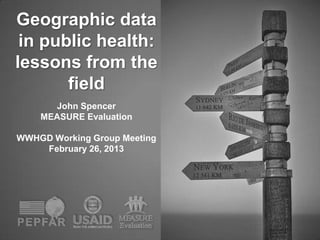
Geographic data in public health: Lessons from the field
- 1. Geographic data in public health: lessons from the field John Spencer MEASURE Evaluation WWHGD Working Group Meeting February 26, 2013
- 2. MEASURE Evaluation USAID funded international monitoring and evaluation project Based at University of North Carolina at Chapel Hill
- 3. MEASURE Evaluation use of spatial data and tools Spatial data and tools are an important resource for monitoring and evaluation of health programs and outcomes
- 4. MEASURE Evaluation Technical assistance to USAID missions, national governments, implementing partners and USAID Washington Trainings and workshops Guidance documents Participation in expert consultations
- 5. The big picture Data barriers have hampered progress more than technical/capacity barriers
- 6. We’ve transitioned to a data rich environment
- 7. Data Issues A lot of paper based records Data quality Lack of geographic identifier Some aspects of health can’t be tied to geography neatly Boundary/administrative issues
- 8. Health and social service sector as a whole, lags behind other sectors in the use of geospatial data and tools
- 9. Two data challenges to confront 1. Isolated data (data silos) 2. Participation of health sector in national spatial data infrastructure efforts
- 10. Isolated data
- 11. A lot of actors on the stage within a country, all with a data and reporting mandate
- 12. Data streams
- 13. Barriers to integration of data
- 14. Payoff can be substantial if effort is made
- 15. Rural Poverty Estimates 2003 and Percent Orphans Served by PEPFAR 2009, Nyanza Province Kisumu Siaya Nyando Bondo Rachuonyo Suba Nyamira Homa Bay Cash Transfer District Kisii Central Gucha Migori (South Kisii) Kuria Map produced May 2010 Poverty Source: Geographic Dimensions of Well Being in Kenya Report, Kenya Cent. Bur. of Stat., 2003 Percent Orphans Served Calculated by dividing 2009 KPMS Number of Orphans Served (table 8.1) by Estimated Number of OVC from NACC Prevalence Report, 2007 (Appx. 3)
- 16. Not rocket science Geography can be the common link across data
- 17. Solutions for data silos 1. Requirements for inclusion of geographic identifiers 2. Data standards Data schema File formats Indicators 3. Some degree of openness with data
- 19. Health and social service sector as a whole, lags behind other sectors in the use of geospatial data and tools
- 20. Health sector and SDI Data, capacity and knowledge sharing often greater outside health sector Leads to duplication of effort in health sector Recreating boundary files Inhibits capacity development Leads to inaction in health sector
- 21. When you bring the health sector to the SDI table, there are benefits across all sectors
- 22. Health sector and SDI CODIST Workshop, Addis Ababa Ethiopia 2009 Nigeria National Mapping Summit 2011 Goals of both events: Bring together health sector and other sectors Identify common goals, data needs, capacity Build a community of practice
- 23. Health sector and SDI CODIST UNECA resolutions including committing member states to ensure that key players in the health sector (especially Nat’l AIDS Commissions) participate in NSDI
- 24. Health sector and SDI Nigeria Mapping Summit Identification of issues across all sectors affecting Nigeria’s ability to improve health outcomes (especially coordination of health and NSDI efforts) Communique presented to executive and legislative branches to encourage collaboration between NSDI and HIV/AIDS efforts
- 25. We’re all in the same boat, when health sector is a partner in SDI, all sectors benefit
- 26. Conclusion More than most sectors, the health sector has deep data roots, yet in many countries, lags behind other sectors in use of spatial tools Software can be taught, capacity in use of software can be built, but strengthening data requires addressing issues at a more systematic level
- 27. Capacity and technical challenges can be overcome, data issues are more challenging
- 28. The research presented here has been supported by the President’s Emergency Plan for AIDS Relief (PEPFAR) through the United States Agency for International Development (USAID) under the terms of MEASURE Evaluation cooperative agreement GHA-A-00-08-00003-00. Views expressed are not necessarily those of PEPFAR, USAID or the United States government. MEASURE Evaluation is implemented by the Carolina Population Center at the University of North Carolina at Chapel Hill in partnership with Futures Group, ICF International, John Snow, Inc., Management Sciences for Health, and Tulane University.
Editor's Notes
- We’re all probably familiar with many of these issues. {REVIEW LIST}But I want to focus on something that was a common theme for our work in Phase III.
- Case studies to illustrate two significant challenges
